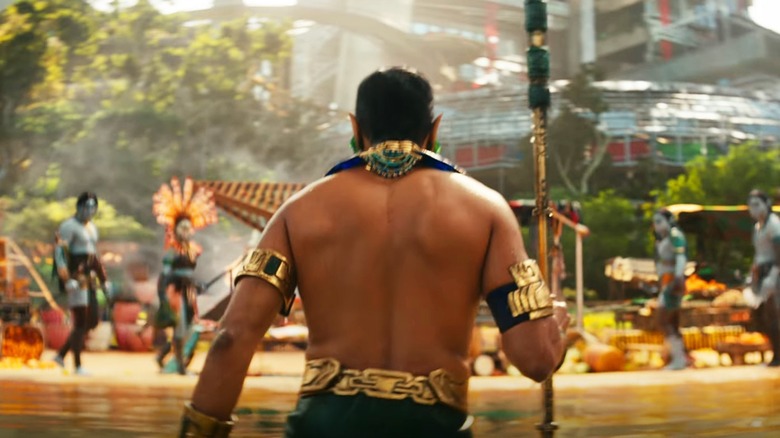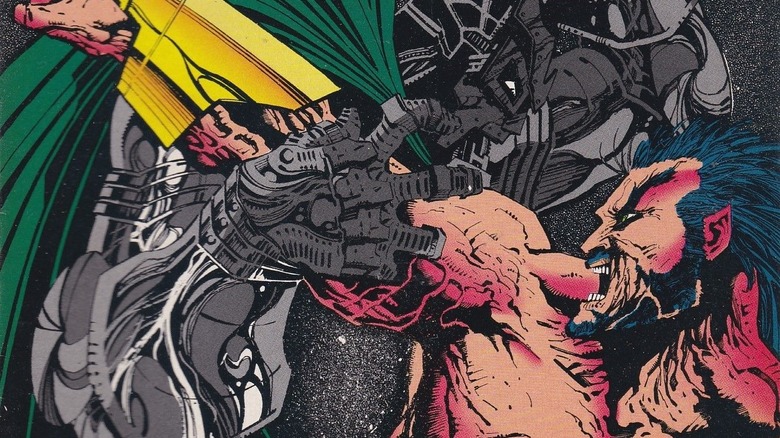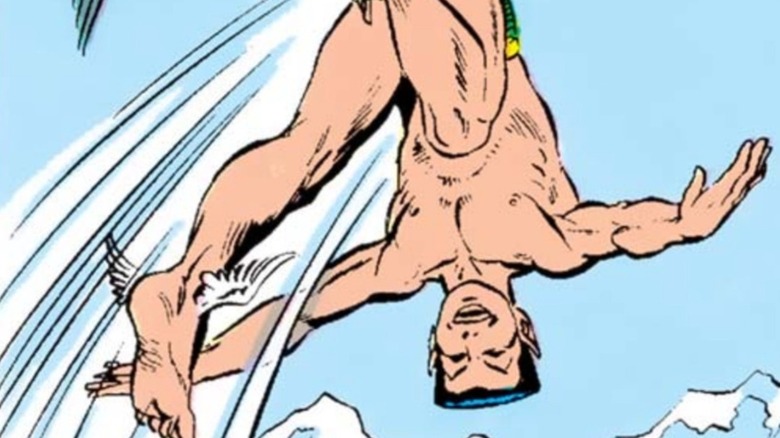Who Is Black Panther: Wakanda Forever's New Character? Namor Explained
Although he was only glimpsed briefly in the trailer for Ryan Coogler's "Black Panther: Wakanda Forever," much online hay has already been made about the fact that Namor the Sub-Mariner was seen emerging from the seas and seemingly doing battle with the Black Panther's home nation of Wakanda. Namor is played by Mexican actor Tenoch Huerta ("The Forever Purge,"), as confirmed by an official announcement that came out of the San Diego Comic Con.
"Wakanda Forever" is set to be released in theaters on November 11, 2022, and since Marvel has always been incredibly ginger with their official press releases (the steady drip of information about Marvel movies is one of the more meticulously crafted marketing triumphs of the modern age) little is yet known about the story. All that is known is that T'Challa has died (a reflection of the real-life loss of "Black Panther" star Chadwick Boseman) and it remains to be seen if someone else will take his place.
Wakanda also appears to be under attack not just from an earthbound military force — there are men with machines guns in fatigues — but from Namor's own people from the underwater nation of Talocan. There are several shots of undersea mer-folk in the "Wakanda Forever" preview, including a baby with Mercury-like wings on his ankles, a few brief shots of that baby growing up amidst scenes of destruction, and then shots of him as an adult standing on the shore amidst a conflagration of some sort.
Namor will likely be a villain in "Wakanda Forever," but may not remain so for the entirety of the film. This posit is based on Namor's origins and personality from the original Marvel Comics, which go back to the very beginning of the company's history.
Namor's comic book origins
Namor the Sub-Mariner was one of the very first superhero characters ever created by the company that was to become Marvel Comics.
The Sub-Mariner was invented by artist and writer Bill Everett in 1939 for the unpublished anthology book "Motion Picture Funnies Weekly" #1, owned by a company called First Funnies, Inc. Only a few test issues of that comic were ever printed (if you have one, call Sotheby's), but the eight-page Sub-Mariner story in that book was eventually expanded to 12 for a new comics label, Timely Comics. Their October 1939 anthology book "Marvel Comics" #1 featured the new and improved Sub-Mariner.
In the '30s and '40s, when superheroes as we know them were just coming into vogue, Timely Comics debuted many heroes that would gain traction in the popular consciousness and eventually become masthead characters at Marvel Comics (as the company would begin calling itself in 1961). Among those early debuts were The Human Torch (a name eventually given to a member of the Fantastic Four), Captain America, his sidekick Bucky, Hellcat, and The Vision. Each of these characters would be re-worked extensively for their 1960s re-debuts.
The comics business shifted a lot during the '40s and '50s, and Timely Comics eventually became Atlas Comics, before Atlas Comics fell to the Marvel brand we now know and love. The early 1960s saw the rapid introductions of many characters and teams that Hollywood has been busy filming for the last 20 years, including Spider-Man, the Hulk, the X-Men, Iron Man, and many, many others. The Sub-Mariner also returned, as the sometime-antagonist-sometime-ally of the Fantastic Four.
Is Namor a hero or a villain?
As his name belies, Namor is an undersea creature: half human and half Atlantean. He is the emperor of the undersea kingdom, and hates people who dwell on dry land. A running character trait through every iteration of Namor is that he only barely accepts alliances from surface-dwellers, if he accepts them at all. He is preachy, annoying, and tactlessly calls out injustice when he sees it. Indeed, in one infamous story, Namor actively tries to seduce the Fantastic Four's Invisible Woman — a married woman — when he sees that Mister Fantastic isn't being the best husband.
Throughout Namor's comic book history, he would constantly teeter on the brink of villainhood — never quite enacting doomsday ploys the way a villain might, but often behaving as a free agent in Marvel Comics, stymieing efforts of more openly righteous heroes. In one notable 1989 Marvel story called "Atlantis Attacks," he actively attacked Earth, aiming to reclaim a stolen Atlantean dragon god. He would help people who asked for his aid, but only if their cause was noble enough to warrant his efforts. It's been posited openly in numerous Marvel comics that if Namor stays out of water for too long, he begins having violent mood swings, explaining why he can be such a jerk.
This last element was explained in the speculative 1999 future-of-Marvel series "Earth X," which attempted to "patch" a lot of the general inconsistencies tha naturally form within a comic book universe that has been in operation for 60 years and has a thousand characters. "Earth X" also lend some of its central ideas to "Eternals," so it may be worth a look if you're the type to speculate about the future of the Marvel Cinematic Universe.
Namor's superpowers
Namor is incredibly long-lived (in the comics the svelte 30-year-old swimmer is, in fact, over 100) and can swim at superhuman speeds as well as fly through the air. The little wings on his ankles seem to have been reason enough for his flight in 1939, so modern writers of comics stick by them. Like Aquaman (invented in 1941, and most assuredly stealing the Sub-Mariner idea) he can communicate with sea animals and convince them to do his bidding. As is par for the course with superheroes, Namor is incredibly strong. And buff. No action figure will be made without showcasing Namor's physique.
In earlier iterations of the character, Namor also had any powers possessed by undersea creatures; he could fling electricity like and eel or inflate his body like a puffer fish. Sadly, he never once vomited up his innards to scare off an attacker the way a sea cucumber might. I don't see why not; it would certainly frighten off the average Joe. These fish powers seem to have been erased from his abilities in later years, giving him a more dramatically limited toolbox of powers.
In true MCU fashion, the filmmakers behind "Wakanda Forever" seem to be taking a slightly different angle on the character, incorporating his hot-headedness and righteous indignation, but in service of a Black Panther story and the world the MCU has spent multiple movies building. For now, the full range of Namor's movie characterization can only be theorized. Given how long the character's history is, the filmmakers will have plenty of material to draw from.



